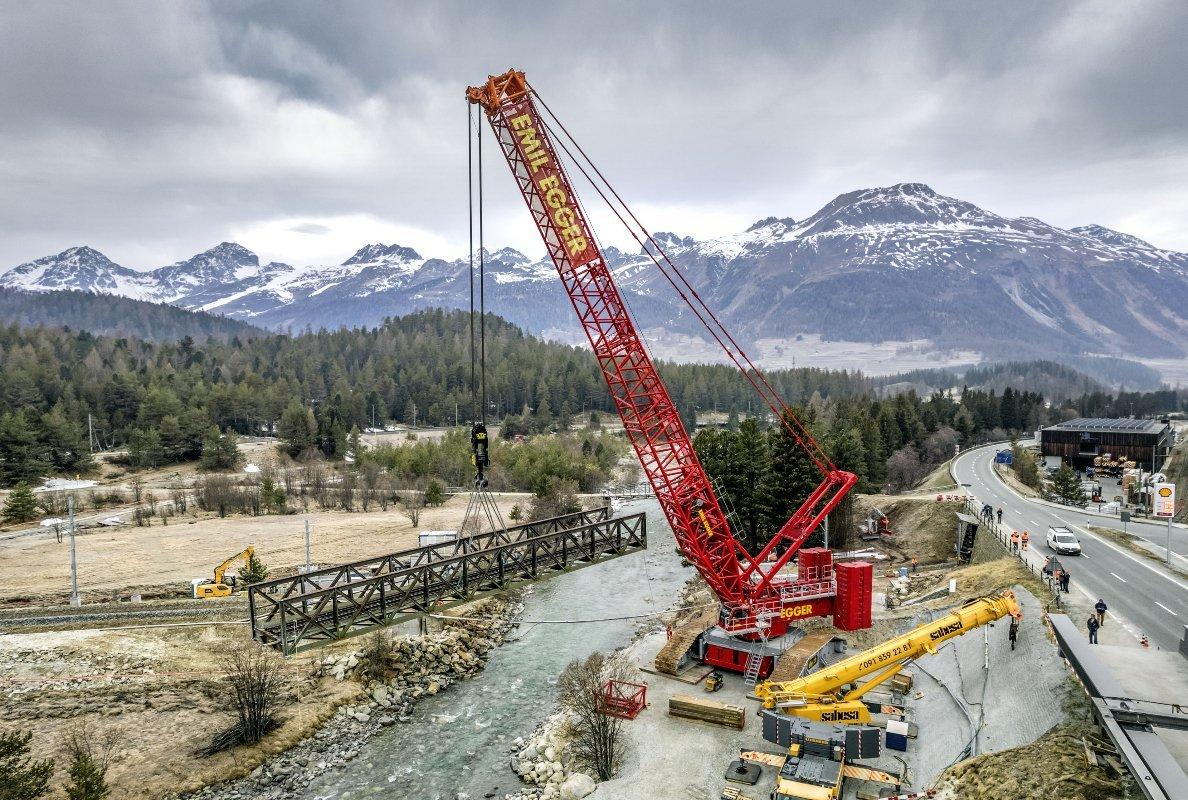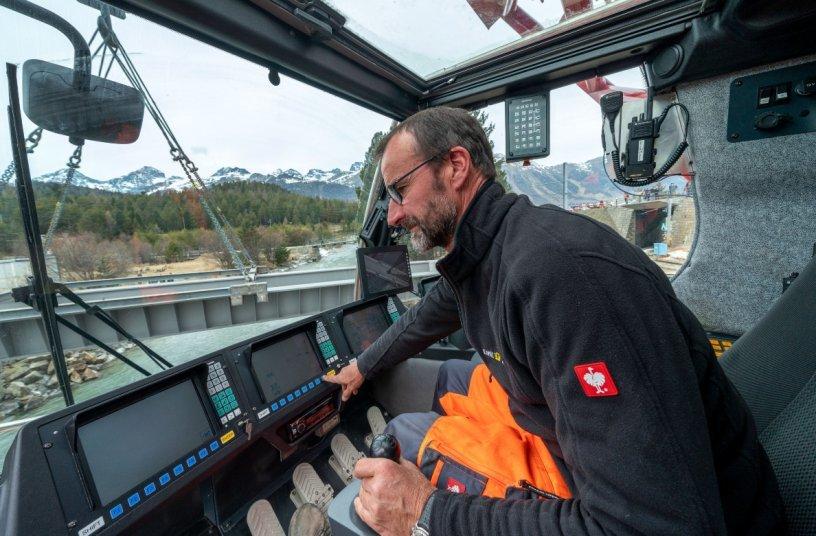Alpine crane job on constricted site
05/08/22-FR-English-NL-footer
La grue sur chenilles Liebherr LR 11000 remplace des ponts ferroviaires dans les Alpes suisses
 Replacement: The old truss bridge has provided sterling service for around 100 years. IMAGE SOURCE: Liebherr-Werk Ehingen GmbH
Replacement: The old truss bridge has provided sterling service for around 100 years. IMAGE SOURCE: Liebherr-Werk Ehingen GmbH
L'augmentation du lest central signifie qu'il n'est pas nécessaire d'utiliser une flèche derrick ou un lest suspendu
Remplacement du premier pont terminé après quelques heures
Une grue sur chenilles Liebherr LR 11000 a installé un pont ferroviaire de 176 tonnes non loin de la station thermale et de villégiature à la mode de Saint-Moritz dans le canton suisse des Grisons. Cette grue sur chenilles la plus puissante de Suisse appartient à l'entreprise de logistique et de transport Emil Egger AG et a effectué le travail à près de 2000 mètres d'altitude dans les Alpes - avec une configuration d'installation inhabituelle en raison du manque d'espace disponible. Au total, trois vieux ponts en treillis du chemin de fer rhétique ont été remplacés par la grue Liebherr.
Michael Egger, directeur général d'Emil Egger AG, basé à Saint-Gall, a transporté sa grue sur chenilles de 1 000 tonnes dans le sud-est de la Suisse pour remplacer trois ponts ferroviaires, tous âgés d'environ 100 ans. Les travaux sur la première structure du pont ont été particulièrement difficiles - en raison de l'espace limité disponible pour la grue sur un remblai métallisé face à la route adjacente, il n'a pas été possible d'utiliser la flèche derrick avec son lest suspendu.
"Afin d'avoir une stabilité suffisante pour lever le nouveau pont ferroviaire nettement plus lourd, nous avons dû maximiser le lest central de la grue pour compenser l'absence de lest suspendu", explique Egger, qui a planifié l'opération avec son collègue Andreas Schönenberger. . Avant d'effectuer les travaux, il avait discuté du cas de charge dans cette configuration inhabituelle avec les spécialistes de Liebherr à Ehingen : « La LR 11000 est équipée de série d'un lest central de 90 tonnes. Nous avons donc chargé 130 tonnes dans la grue pour cette opération après que Liebherr nous ait donné le feu vert pour le faire." Le lest de la plate-forme pivotante était chargé d'un contrepoids maximum de 250 tonnes.
Vue panoramique - Peter Stricker, dans la cabine du grutier du LR 11000, place le pont en acier de 176 tonnes précisément sur les culées du franchissement rénové.

Panoramic view – Peter Stricker, in the crane operator’s cab of the LR 11000, places the 176 tonne steel bridge precisely on the abutments of the refurbished river crossing.
IMAGE SOURCE: Liebherr-Werk Ehingen GmbH
Avant que la nouvelle structure en acier, qui mesure environ 35 mètres de long et a été assemblée sur place à partir de plusieurs segments, puisse être mise en place, l'ancienne structure du pont a d'abord dû être enlevée. La construction en treillis de 65 tonnes a été rapidement soulevée des culées et déposée au bord de la rivière de montagne, en fait à côté de LR 11000. Elle a ensuite été repositionnée plus tard pour être enlevée. Ensuite, la grue sur chenilles a pu soulever le nouveau pont du transporteur spécial sur la route et le positionner au-dessus de la rivière dans un rayon d'environ 22 mètres. "Avec ce rayon et un cas de charge brute de 205 tonnes, nous sommes presque à la limite du tableau de charge pour la grue dans cette configuration particulière", déclare Egger.
Le LR 11000 a été monté et démonté par une grue mobile Liebherr LTM 1250-6.1 appartenant à Sabesa SA, un entrepreneur de grues et de transport basé au Tessin. Andrea Saccomandi, directeur général de Sabesa, qui était en fait l'entrepreneur principal pour le remplacement des trois ponts ferroviaires, était personnellement sur place pour le travail de la grue. Basée sur la rive nord du lac Majeur, l'entreprise propose des travaux de grue, des services de transport et de location de plates-formes, et sa flotte comprend une douzaine de grues de construction mobiles, compactes et mobiles Liebherr.
NJC.© Info Liebherr-Werk Ehingen GmbH
-----------------------------------------------------------------------------------------------------------------------
05/08/22-English
Liebherr LR 11000 crawler crane replaces railway bridges in the Swiss Alps
 Replacement: The old truss bridge has provided sterling service for around 100 years. IMAGE SOURCE: Liebherr-Werk Ehingen GmbH
Replacement: The old truss bridge has provided sterling service for around 100 years. IMAGE SOURCE: Liebherr-Werk Ehingen GmbH
Increased central ballast means no need for a derrick boom or suspended ballast
First bridge replacement completed after a few hours
A Liebherr LR 11000 crawler crane has installed a 176-tonne railway bridge not far from the fashionable spa and holiday resort of St. Moritz in the Swiss canton of Graubünden. This, the most powerful crawler crane in Switzerland, belongs to logistics and haulage contractor Emil Egger AG and did the job at an altitude of almost 2,000 metres in the Alps - with an unusual set-up configuration due to the lack of available space. A total of three aged truss bridges of the Rhaetian Railway were replaced by the Liebherr crane.
Michael Egger, Managing Director of Emil Egger AG, based in St. Gallen, transported his 1,000-tonne crawler crane to the south-east of Switzerland to replace three railway bridges, all of which were around 100 years old. Work on the first bridge structure was particularly challenging – due to the limited space available for the crane on a metalled embankment facing the adjacent road, it was not possible to use the derrick boom with its suspended ballast.
"To ensure we have sufficient stability for lifting the new, significantly heavier railway bridge, we had to maximise the central ballast on the crane to compensate for the lack of suspended ballast," explains Egger, who planned the operation with his colleague, Andreas Schönenberger. Prior to carrying out the work, he had discussed the load case in this unusual configuration with the specialists at Liebherr in Ehingen: "The LR 11000 is equipped with 90 tonnes of central ballast as standard. We have therefore packed 130 tonnes into the crane for this operation after Liebherr gave us the OK to do so." The slewing platform ballast was loaded with the maximum counterweight of 250 tonnes.
Panoramic view – Peter Stricker, in the crane operator’s cab of the LR 11000, places the 176 tonne steel bridge precisely on the abutments of the refurbished river crossing.

Panoramic view – Peter Stricker, in the crane operator’s cab of the LR 11000, places the 176 tonne steel bridge precisely on the abutments of the refurbished river crossing.
IMAGE SOURCE: Liebherr-Werk Ehingen GmbH
Before the new steel structure, which is around 35 metres long and was assembled on site from several segments, could be placed in position, the old bridge structure first had to be removed. The 65-tonne truss construction was quickly lifted off the abutments and set down on the edge of the mountain river, actually next to LR 11000. It was then repositioned later for removal. Afterwards, the crawler crane was able to lift the new bridge from the special transporter on the road and position it above the river using a radius of around 22 metres. "With this radius and a gross load case of 205 tonnes, we are almost at the limit of the load chart for the crane in this particular configuration," says Egger.
The LR 11000 was erected and dismantled by a Liebherr LTM 1250-6.1 mobile crane belonging to Sabesa SA, a crane and haulage contractor based in Ticino. Andrea Saccomandi, Managing Director of Sabesa, which was actually the main contractor for the replacement of the three railway bridges, was personally on site for the crane job. Based on the northern shore of Lake Maggiore, the company's portfolio includes crane work, transport services and platform hire, and its fleet includes around a dozen Liebherr mobile, compact and mobile construction cranes.
NJC.© Info Liebherr-Werk Ehingen GmbH
-----------------------------------------------------------------------------------------------------------------
05/08/22-NL
Liebherr LR 11000 rupskraan vervangt spoorbruggen in de Zwitserse Alpen

Replacement: The old truss bridge has provided sterling service for around 100 years. IMAGE SOURCE: Liebherr-Werk Ehingen GmbH
Verhoogde centrale ballast betekent dat er geen derrickboom of hangende ballast nodig is
Eerste brugvervanging na een paar uur voltooid
Een Liebherr LR 11000 rupskraan heeft een spoorbrug van 176 ton geïnstalleerd niet ver van het mondaine kuur- en vakantieoord St. Moritz in het Zwitserse kanton Graubünden. Deze, de krachtigste rupskraan in Zwitserland, is van logistiek- en transportaannemer Emil Egger AG en deed het werk op een hoogte van bijna 2.000 meter in de Alpen - met een ongebruikelijke opstellingsconfiguratie vanwege het gebrek aan beschikbare ruimte. In totaal werden drie oude vakwerkbruggen van de Rhätische Bahn vervangen door de Liebherr-kraan.
Michael Egger, algemeen directeur van Emil Egger AG, gevestigd in St. Gallen, vervoerde zijn 1000-tons rupskraan naar het zuidoosten van Zwitserland om drie spoorbruggen te vervangen, die allemaal ongeveer 100 jaar oud waren. Het werk aan de eerste brugconstructie was bijzonder uitdagend - vanwege de beperkte beschikbare ruimte voor de kraan op een verharde dijk tegenover de aangrenzende weg, was het niet mogelijk om de derrickgiek met zijn hangende ballast te gebruiken.
"Om ervoor te zorgen dat we voldoende stabiliteit hebben om de nieuwe, aanzienlijk zwaardere spoorbrug op te tillen, moesten we de centrale ballast op de kraan maximaliseren om het gebrek aan hangende ballast te compenseren", legt Egger uit, die de operatie samen met zijn collega Andreas Schönenberger plande. . Voorafgaand aan het uitvoeren van de werkzaamheden had hij het belastinggeval in deze ongebruikelijke configuratie besproken met de specialisten van Liebherr in Ehingen: "De LR 11000 is standaard uitgerust met 90 ton centrale ballast. We hebben daarom 130 ton in de kraan gepakt voor deze operatie nadat Liebherr ons toestemming had gegeven om dit te doen." De ballast van het zwenkplatform was beladen met de maximale ballast van 250 ton.
Panoramisch zicht – Peter Stricker plaatst in de kraancabine van de LR 11000 de stalen brug van 176 ton precies op de landhoofden van de gerenoveerde rivierovergang.

Panoramic view – Peter Stricker, in the crane operator’s cab of the LR 11000, places the 176 tonne steel bridge precisely on the abutments of the refurbished river crossing.
IMAGE SOURCE: Liebherr-Werk Ehingen GmbH
Voordat de nieuwe staalconstructie, die zo'n 35 meter lang is en ter plaatse uit meerdere segmenten is samengesteld, kon worden geplaatst, moest eerst de oude brugconstructie worden verwijderd. De 65-tons spantconstructie werd snel van de landhoofden getild en neergezet op de rand van de bergrivier, eigenlijk naast de LR 11000. Later werd hij verplaatst om te worden verwijderd. Daarna heeft de rupskraan de nieuwe brug van de speciale transporter op de weg kunnen tillen en in een straal van circa 22 meter boven de rivier kunnen positioneren. "Met deze straal en een brutolastgeval van 205 ton zitten we bijna aan de limiet van het lastdiagram voor de kraan in deze specifieke configuratie", zegt Egger.
De LR 11000 werd opgebouwd en gedemonteerd door een Liebherr LTM 1250-6.1 mobiele kraan van Sabesa SA, een kraan- en transportaannemer gevestigd in Ticino. Andrea Saccomandi, algemeen directeur van Sabesa, dat feitelijk de hoofdaannemer was voor de vervanging van de drie spoorbruggen, was persoonlijk ter plaatse voor de kraanklus. Het bedrijf, dat aan de noordelijke oever van het Lago Maggiore ligt, omvat kraanwerk, transportdiensten en platformverhuur, en de vloot omvat ongeveer een dozijn mobiele, compacte en mobiele bouwkranen van Liebherr.
NJC.© Info Liebherr-Werk Ehingen GmbH
------------------------------------------------------------------------------------------------------------------
Date de dernière mise à jour : 05/08/2022
















